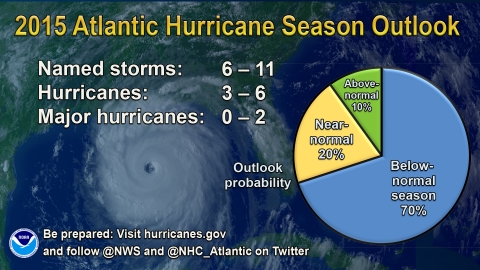May272015
Posted at 11:59 AM
NOAA’s Climate Prediction Center says the 2015 Atlantic hurricane season will likely be below-normal, but that’s no reason to believe coastal areas will have it easy.
For the hurricane season, which officially runs from June 1 to November 30, NOAA is predicting a 70 percent likelihood of 6 to 11 named storms (winds of 39 mph or higher), of which 3 to 6 could become hurricanes (winds of 74 mph or higher), including zero to 2 major hurricanes (Category 3, 4 or 5; winds of 111 mph or higher). While a below-normal season is likely (70 percent), there is also a 20 percent chance of a near-normal season, and a 10 percent chance of an above-normal season.
Included in today’s outlook is Tropical Storm Ana, but its pre-season development is not an indicator of the overall season strength. Ana’s development was typical of pre-season named storms, which often form along frontal boundaries in association with a trough in the jet stream. This method of formation differs from the named storms during the peak of the season, which originate mainly from low-pressure systems moving westward from Africa, and are independent of frontal boundaries and the jet stream.
With the new hurricane season comes a new prototype storm surge watch/warning graphic from NOAA’s National Hurricane Center, intended to highlight areas along the Gulf and Atlantic coasts of the United States that have a significant risk of life-threatening inundation by storm surge from a tropical cyclone.
The new graphic will introduce the concept of a watch or warning specific to the storm surge hazard. Storm surge is often the greatest threat to life and property from a tropical cyclone, and it can occur at different times and at different locations from a storm’s hazardous winds. In addition, while most coastal residents can remain in their homes and be safe from a tropical cyclone’s winds, evacuations are often needed to keep people safe from storm surge. Having separate warnings for these two hazards should provide emergency managers, the media, and the general public better guidance on the hazards they face when tropical cyclones threaten.
Also new this season is a higher resolution version (2 km near the storm area) of NOAA's Hurricane Weather Research and Forecasting model (HWRF), thanks to the upgrades to operational computing. A new 40-member HWRF ensemble-based data assimilation system will also be implemented to make better use of aircraft reconnaissance-based Tail Doppler Radar data for improved intensity forecasts. Retrospective testing of 2015 HWRF upgrades demonstrated a five percent improvement in the intensity forecasts compared to last year.
This week, May 24-30, is National Hurricane Preparedness Week. To help those living in hurricane-prone areas prepare, NOAA offers hurricane preparedness tips, along with video and audio public service announcements at www.hurricanes.gov/prepare.
NOAA will issue an updated outlook for the Atlantic hurricane season in early August, just prior to the historical peak of the season.
NOAA also issued its outlook for the Eastern Pacific and Central Pacific basins. For the Eastern Pacific hurricane basin, NOAA’s 2015 outlook is for a 70 percent chance of an above-normal hurricane season. That outlook calls for a 70 percent probability of 15 to 22 named storms, of which 7 to 12 are expected to become hurricanes, including 5 to 8 major hurricanes. For the Central Pacific hurricane basin, NOAA’s outlook is for a 70 percent chance of an above-normal season with 5 to 8 tropical cyclones likely.




